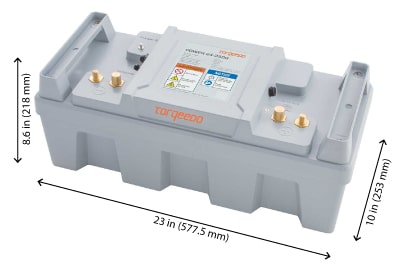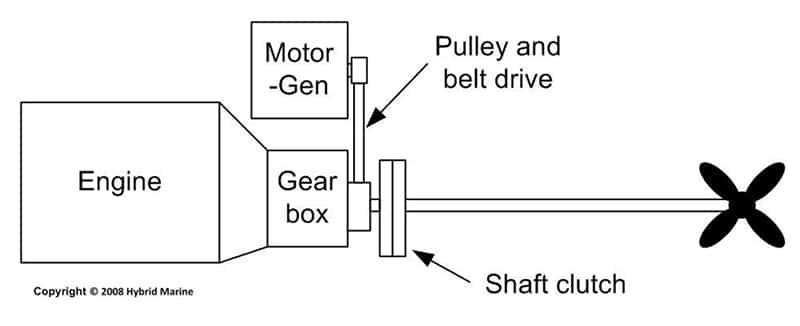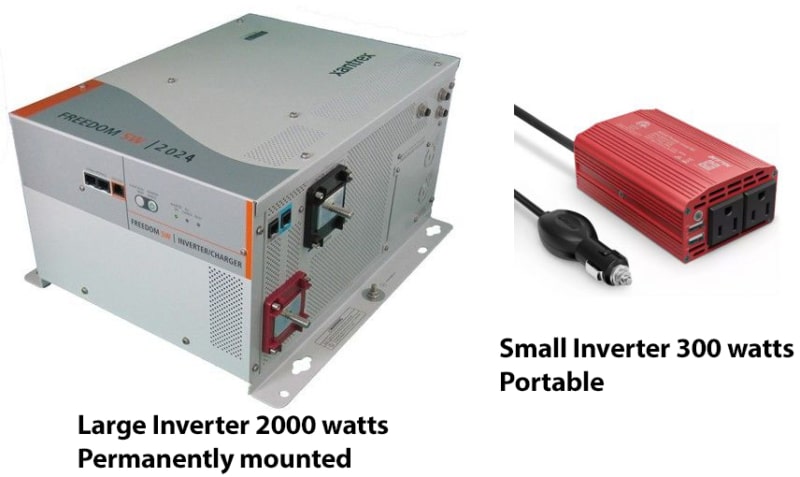Particulars and suggestions for understanding power in your boat
Managing Power in your boat is like managing water in your boat – there’s a restricted provide and you must always prime it up as you employ it.
With the maturity of Lithium-Ion batteries and excessive capability storage, individuals search for smarter and sooner methods to generate extra power in your boat. Whereas photo voltaic will at all times be an inexpensive and simply obtainable supply of power, for at this time’s trendy boat with all the specified creature comforts – such because the array of electronics, refrigeration, electrical ovens, water heaters, water makers, air-con, and extra – photo voltaic can’t sustain.
Energy vs Power in your Boat
Power:
The idea of power is likened to water for the best understanding. A bucket of water holds a certain quantity of water that’s measured in quite a lot of gallons or liters. It’s finite: when it’s all drained out, it’s gone. To realize extra, it have to be changed from a water supply.
In the identical method, power is measured in a amount like gallons or liters are to water. Power amount is measured in joules. The battery itself is likened to the bucket. The battery holds a specific amount of joules of power and when it’s all gone, it’s gone. To realize extra usable electrical energy in your boat, you have to add extra joules again into your battery.

Energy:
The idea of energy is likened to a amount of water flowing out of the bucket over time. Whereas draining the bucket of water, the water is flowing out at a sure fee. If a 10-liter bucket drains out in 1 minute, the stream fee out is 10 liters per minute or 600 liters per hour.
Energy is the stream fee or utilization of power over time measured in joules of power per second of time. One joule of power used each second is one watt of energy. Thus, electrical gadgets are rated in watts – the quantity of power per second the gadget makes use of whereas it’s ‘on’. The longer you permit the gadget on, the larger quantity of power is consumed and drained out of your restricted useful resource energy-holding batteries.
To summarize the above: Power is a amount, and energy is the speed of utilization of that power over time.
If you find yourself on a sailboat on a crusing trip or cruising, you’re the power supervisor. As such, you’re going to want to grasp the arithmetic of all of it and always do power audits. When crusing at house, that is not often a problem as a result of sometimes on the finish of the day you return house and plug into the shore energy to recharge your batteries. When crusing overseas or on prolonged journeys, plugging into shore energy not often occurs each evening.
To place this all in perspective, a fridge/freezer unit on a sailboat is usually rated at 60 watts. Because of this each second it’s on and cooling it makes use of 60 joules of power. However like a fridge at house, the fridge shouldn’t be at all times working. It cools right down to the suitable temperature then the thermostat switches the fridge off. When warmth enters in by the partitions of the fridge and raises the temperature just a few levels, the fridge turns again on and begins consuming 60 watts of energy or 60 joules of power each second to chill the fridge again right down to its thermostat setting – then is switches itself off once more.
Let’s say you load the fridge up with heat beer. After 1 hour of full working the fridge would have used:
60 j/sec * 3600 sec/hr * 1 hr = 216,000 joules.
However that quantity, 216,000 joules actually doesn’t imply a lot. So engineers simplified the idea utilizing watt-hours, which can be a measure of power (1 watt-hr = 1 joule/sec * 3600 sec/hr = 3600 joules). Since energy (the stream fee of power) is measured in watts, it’s extra virtually significant to record power in watt-hrs as an alternative of joules. i.e. in the event you use 1 joule per second for 3,600 seconds you’ll have used 3,600 joules. Since one joule per second is one watt and three,600 seconds is one hour that is 1 watt.hour (watt.hr). This isn’t watts per hour – there is no such thing as a such factor – moderately watt.hrs is the stream fee of power (watts) multiplied by time (hours) and is thus watt.hours – a certain quantity of power used. In water phrases, that is like liters/hour (akin to watts) multiplied by time (hours) – which is the quantity of liters used.
Tip: Engineers use watt-hrs because the significant unit of power
On this case, the 60-watt fridge/freezer ran for 1 hour and used 60 watt.hrs of power from the home battery financial institution. If the fridge/freezer ran on full cooling for twenty-four hours then it might use:
60 watts x 24 hours = 1440 watt-hours of power (or 1.44. kilowatt-hrs)
In actuality, the fridge doesn’t run 100% of the time (until loaded with heat stuff). The % of time it runs known as the responsibility cycle. Assuming the responsibility cycle is 50% then a full day of working the fridge and maintaining the beer (and meals) chilly consumes 720 watt-hrs or 0.72 kilowatt-hrs of power.
Battery Capability Rankings
Sadly, somebody determined to measure lead-acid battery power capability in Amp-hrs. In actuality, there is no such thing as a unit of measurement as an Amp.hr and it drives engineers loopy. Amps must be multiplied by the voltage to place it into actual phrases. For instance, a 200 Amp.hr battery at 12 volts incorporates half the quantity of power as a 200 Amp.hr battery at 24 volts. So, Amp.hrs can be a nonsensical measurement of power.
A extra sensible power capability score of batteries is in watt.hrs. This enables anybody to simply calculate how lengthy a battery will final at a sure wattage drain fee as the instance above with the fridge. With the appearance of Lithium-Ion batteries, happily, the scores have now been universally listed in watt.hrs – whew. This makes the calculation of quantity of accessible power straightforward for the mariner.

How a lot power?
We added up all of the power attracts on a typical 40-foot boat with trendy facilities. The conclusion was, on common, the boat will use about 5000 watt.hrs of power per day – that is excluding air-con. This makes the maths very easy – the three,500 watt.hr Lithium-Ion battery above totally charged would offer 3500/5000 = 70% of the each day requirement.
While you add in air-con, the numbers go loopy. NauticEd carried out an experiment on a Beneteau 41 monohull in Caribbean kind circumstances – 80o F water temperature and 78oair temp at evening. The air-con thermostat was set at 75o F. It was discovered that with 4 individuals sleeping onboard, the quantity of power consumed was 1,400 watt.hrs per hour. For a ten hour night utilizing air-con, because of this 14,000 watt.hrs of power could be consumed only for air-con. That may be a lot: 4 of the lithium-ion batteries above!
Sources of Power
Photo voltaic: Photo voltaic panels are conveniently and correctly rated in watts – Joules of power transformed from solar power per second to electrical power. And truly, they’re actually rated in watts per sq. meter. The perfect photo voltaic panels at this time can produce about 300 watts per sq. meter. A giant catamaran might need house for an array of about 6 sq. meters of panels (2m x 3m). This array can produce 300 watts/m2 x 6 m2 = 1800 watts. As a basic rule of thumb, on a sunny day, you possibly can multiply this by about 5 hours per day to achieve the quantity of power produced. Thus a big array on a catamaran might produce as much as about 9000 watt.hrs of power. A monohull has considerably much less obtainable space for mounting photo voltaic panels and so 2 sq. meters is extra reasonable. This implies 300 watt/m2 x 2 m2 x 5 hrs = 3000 watt.hrs per day might be produced from photo voltaic.
Thus whereas photo voltaic is able to taking an enormous dent out of the power used per day, in the event you add in air-con, photo voltaic can’t sustain. You must get extra power from different sources.

Alternator: An alternator doesn’t produce very a lot power regardless of it being linked to the engine. That is principally due to the restricted “dumb” electronics within the alternator such because the diode. An alternator will produce about 800 watts of power. For each hour of engine run time, you solely generate 800 watt.hrs which isn’t sufficient even when working the engine for 3 hours (2400 watt.hrs).
Generator: A generator onboard your boat is usually a main supply of power. A typical marine generator that may match on a 45-foot monohull supplies as much as 8,000 watts. This may sustain with the height load of all air conditioners working at full pace in addition to all of your electronics. Turbines are heavy and costly to purchase and operational upkeep can be costly. Basically, a generator is simply one other diesel engine that has {an electrical} producing gadget hooked up to it. It has soundproofing round it to reduce the noise, however in the event you’re working air-con out of your generator, you’re going to be listening to the thrumb all evening (in addition to your neighbors).

Excessive Output Alternators: Some alternators have been designed to output a considerable amount of power as a lot as 3000 watts. Nonetheless, these alternators have developed a popularity for being unreliable and infrequently the diodes blow from surges of power when throttling the propulsion engine up and down as you maneuver in a marina.
Clever Alternators (Integrel): A number of makes an attempt at good alternators have been carried out which draw energy off the entrance pulley by way of a big belt with a really stiff tensioner. One such is the Integrel gadget which NauticEd initially endorsed as a result of its innovation. Nonetheless, Integrel has confirmed to be not dependable over time due to belt put on and breakage, excessive hundreds on the alternator bracket main it to bend, in addition to fatigue hundreds on the bracket bolts. Moreover, fixed points with the complicated software program result in many set up issues costing many hundreds of {dollars} to the installer and additional ongoing operational issues to the consumer. The difficulty with Integrel actually comes right down to making an attempt to drag an excessive amount of power off the entrance pulley. Consequently, the engine producers have denied guarantee protection. Integrel is made by Triskel Marine within the UK – a small start-up firm that did have an amazing concept however didn’t implement it correctly. Our recommendation is to keep away from the Integrel – there are different extra revolutionary gadgets coming like hybrid engine/mills. See this text on why Integrel didn’t work.
Hybrid Engine/Turbines: These are going to be seen increasingly on sailboats and powerboats and seemingly are the final resolution.
The parallel hybrid system makes use of the excessive energy obtainable from the drive shaft pushed by the diesel propulsion engine. Between the engine and the propeller, a wise clutch/gearbox is inserted. The clutch can ship mechanical energy to the propeller in addition to to an electrical generator. The electrical generator creates electrical energy and shops it in a 48-volt financial institution of batteries for later utilization. What’s intelligent about this technique is that the electrical generator can double as an electrical motor, so now if the 48-volt financial institution of batteries are full and the mariner decides to run their boat propulsion on electrical energy, they’ll swap off the diesel engine and permit the electrical motor to drive the propeller by the clutch/gearbox.
The design under is equipped by Hybrid Marine (www.hybrid-marine.co.uk)

For additional understanding on this explicit product from Hybrid Marine see: https://www.hybrid-marine.co.uk/index.php/hybrid-info/how-our-hybrid-work though there are different producers on the market. NauticEd has no relationship with Hybrid Marine and can’t converse relating to their actual expertise however does acknowledge that two main boat producers, Antares Catamarans and HH Catamarans, are utilizing their expertise.
The 48-volt financial institution of batteries charged from the motor/generator additionally doubles as a big storage of power to be used onboard for air conditioners, fridges, and boat electronics, and so on.
The good mariner then simply makes selections about his saved electrical power and runs the diesel or electrical motor as acceptable. When at anchor, if there may be not sufficient power within the 48-volt financial institution, electrical energy can simply be produced from the principle engine by the electrical generator.
This hybrid system utterly eliminates the normal generator which is simply one other diesel engine onboard with related weight and value.
Utilizing the hybrid system will enable the mariner to generate an enormous quantity {of electrical} power in a short time and retailer it in Lithium-ion batteries. For instance, if a catamaran makes use of 20 kW.hrs of power for its air-con on an evening, this quantity of power may very well be generated in 2 hours of twin engine run time versus working a generator all evening lengthy. Add photo voltaic and you’ll reduce that in half. Electrical power will also be generated whereas utilizing the spare obtainable power from the propulsion engines even whereas maneuvering in gear.
Wind Generators: Producers fee their generators for 28 knots of wind pace. However energy output from wind generators decreases by the third mathematical energy with wind pace. So in the event you half 28 knots to 14 knots, an impressive-sounding 400 watt rated wind turbine can solely produce 50 watts.
Water stream mills: As water flows over the propeller whereas the boat is crusing which turns the propeller. This may be harnessed into electrical power. Many hybrid methods as above have this functionality constructed into their system. Whereas this provides to your incoming power, it depends on you crusing (lots).
Inverters and Converters
An inverter shouldn’t be actually a supply of power in your boat. It adjustments electrical saved power in batteries into 110 vAC or 220 vAC (alternating present) power. AC is what your bigger home equipment run on akin to a microwave and is similar as you might have in your own home. Thus to run AC home equipment out of your batteries, you want an inverter. Inverters are rated in watts (the quantity of watts must be larger than the home equipment you need to join).
You may get a big inverter that’s completely mounted into your boat for working such gadgets as microwaves or a smaller moveable inverter that may create a small quantity of 110v/220v present for charging laptops and the like.

Equally however reverse, a converter converts AC electrical energy into DC electrical energy. An instance is the battery charger which takes electrical energy from the shore energy or from the generator and makes use of it to cost the batteries. Moreover, a converter can change one DC voltage to a different DC voltage – e.g. 48vDC right down to 12vDC.
And only for completeness, a transformer adjustments from one AC voltage to a different – e.g. 220vAC right down to 110vAC or 110vAC as much as 220vAC. You discover these on boats which are world cruisers shifting between continents and nations.
Conclusion
Working out of power in your boat sucks. It is going to imply heat drinks, meals going off within the heat fridge, navigation tools happening, and worse. The prudent captain will monitor and handle power utilization identical to consuming water on the boat. Coaching your crew to be power conservative is a good suggestion. Air-con is the largest power drain so attempt to use pure cooling like wind scoops.
Lithium-Ion batteries are a expertise reward to the marina however environment friendly methods of topping up these batteries must be thought-about akin to photo voltaic and hybrid engine/generator methods.

